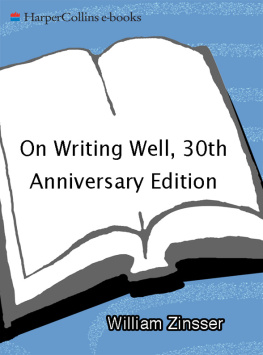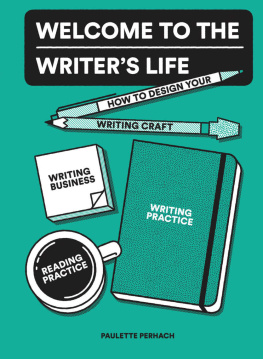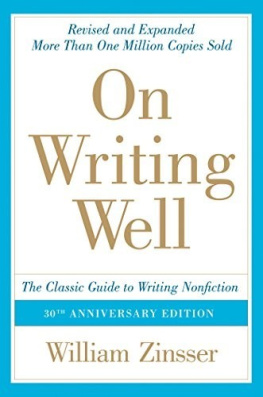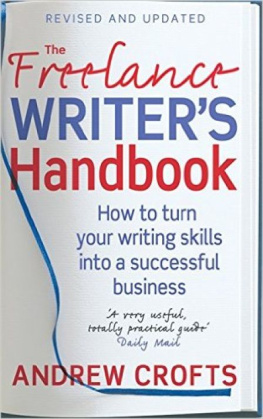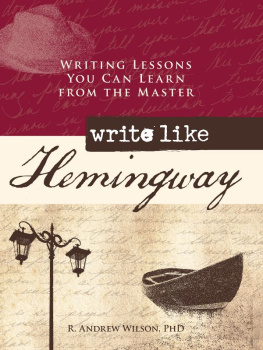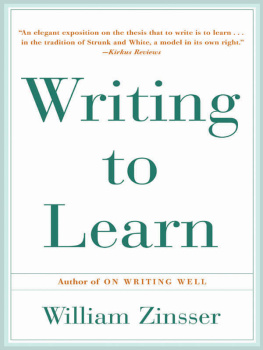On
Writing
Well
30th Anniversary Edition

T HE C LASSIC G UIDE TO
W RITING N ONFICTION
William Zinsser

CONTENTS


One of the pictures hanging in my office in mid-Manhattan is a photograph of the writer E. B. White. It was taken by Jill Krementz when White was 77 years old, at his home in North Brooklin, Maine. A white-haired man is sitting on a plain wooden bench at a plain wooden tablethree boards nailed to four legsin a small boathouse. The window is open to a view across the water. White is typing on a manual typewriter, and the only other objects are an ashtray and a nail keg. The keg, I dont have to be told, is his wastebasket.
Many people from many corners of my lifewriters and aspiring writers, students and former studentshave seen that picture. They come to talk through a writing problem or to catch me up on their lives. But usually it doesnt take more than a few minutes for their eye to be drawn to the old man sitting at the typewriter. What gets their attention is the simplicity of the process. White has everything he needs: a writing implement, a piece of paper, and a receptacle for all the sentences that didnt come out the way he wanted them to.
Since then writing has gone electronic. Computers have replaced the typewriter, the delete key has replaced the wastebasket, and various other keys insert, move and rearrange whole chunks of text. But nothing has replaced the writer. He or she is still stuck with the same old job of saying something that other people will want to read. Thats the point of the photograph, and its still the point30 years laterof this book.
I first wrote On Writing Well in an outbuilding in Connecticut that was as small and as crude as Whites boathouse. My tools were a dangling lightbulb, an Underwood standard typewriter, a ream of yellow copy paper and a wire wastebasket. I had then been teaching my nonfiction writing course at Yale for five years, and I wanted to use the summer of 1975 to try to put the course into a book.
E. B. White, as it happened, was very much on my mind. I had long considered him my model as a writer. His was the seemingly effortless styleachieved, I knew, with great effortthat I wanted to emulate, and whenever I began a new project I would first read some White to get his cadences into my ear. But now I also had a pedagogical interest: White was the reigning champ of the arena I was trying to enter. The Elements of Style, his updating of the book that had most influenced him, written in 1919 by his English professor at Cornell, William Strunk Jr., was the dominant how-to manual for writers. Tough competition.
Instead of competing with the Strunk & White book I decided to complement it. The Elements of Style was a book of pointers and admonitions: do this, dont do that. What it didnt address was how to apply those principles to the various forms that nonfiction writing and journalism can take. Thats what I taught in my course, and its what I would teach in my book: how to write about people and places, science and technology, history and medicine, business and education, sports and the arts and everything else under the sun thats waiting to be written about.
So On Writing Well was born, in 1976, and its now in its third generation of readers, its sales well over a million. Today I often meet young newspaper reporters who were given the book by the editor who hired them, just as those editors were first given the book by the editor who hired them. I also often meet gray-haired matrons who remember being assigned the book in college and not finding it the horrible medicine they expected. Sometimes they bring that early edition for me to sign, its sentences highlighted in yellow. They apologize for the mess. I love the mess.
As America has steadily changed in 30 years, so has the book. Ive revised it six times to keep pace with new social trends (more interest in memoir, business, science and sports), new literary trends (more women writing nonfiction), new demographic patterns (more writers from other cultural traditions), new technologies (the computer) and new words and usages. Ive also incorporated lessons I learned by continuing to wrestle with the craft myself, writing books on subjects I hadnt tried before: baseball and music and American history. My purpose is to make myself and my experience available. If readers connect with my book its because they dont think theyre hearing from an English professor. Theyre hearing from a working writer.
My concerns as a teacher have also shifted. Im more interested in the intangibles that produce good writingconfidence, enjoyment, intention, integrityand Ive written new chapters on those values. Since the 1990s Ive also taught an adult course on memoir and family history at the New School. My students are men and women who want to use writing to try to understand who they are and what heritage they were born into. Year after year their stories take me deeply into their lives and into their yearning to leave a record of what they have done and thought and felt. Half the people in America, it seems, are writing a memoir.
The bad news is that most of them are paralyzed by the size of the task. How can they even begin to impose a coherent shape on the pastthat vast sprawl of half-remembered people and events and emotions? Many are near despair. To offer some help and comfort I wrote a book in 2004 called Writing About Your Life. Its a memoir of various events in my own life, but its also a teaching book: along the way I explain the writing decisions I made. They are the same decisions that confront every writer going in search of his or her past: matters of selection, reduction, organization and tone. Now, for this seventh edition, Ive put the lessons I learned into a new chapter called Writing Family History and Memoir.
When I first wrote On Writing Well, the readers I had in mind were a small segment of the population: students, writers, editors, teachers and people who wanted to learn how to write. I had no inkling of the electronic marvels that would soon revolutionize the act of writing. First came the word processor, in the 1980s, which made the computer an everyday tool for people who had never thought of themselves as writers. Then came the Internet and e-mail, in the 1990s, which continued the revolution. Today everybody in the world is writing to everybody else, making instant contact across every border and across every time zone. Bloggers are saturating the globe.
On one level the new torrent is good news. Any invention that reduces the fear of writing is up there with air-conditioning and the lightbulb. But, as always, theres a catch. Nobody told all the new computer writers that the essence of writing is rewriting. Just because theyre writing fluently doesnt mean theyre writing well.
That condition was first revealed with the arrival of the word processor. Two opposite things happened: good writers got better and bad writers got worse. Good writers welcomed the gift of being able to fuss endlessly with their sentencespruning and revising and reshapingwithout the drudgery of retyping. Bad writers became even more verbose because writing was suddenly so easy and their sentences looked so pretty on the screen. How could such beautiful sentences not be perfect?
Next page
